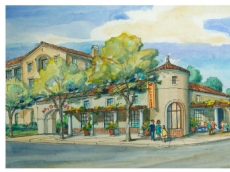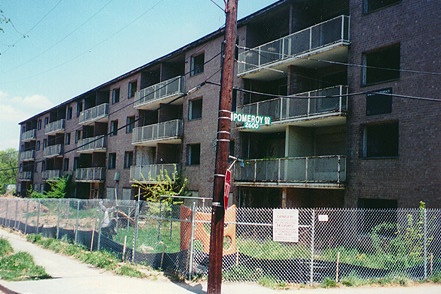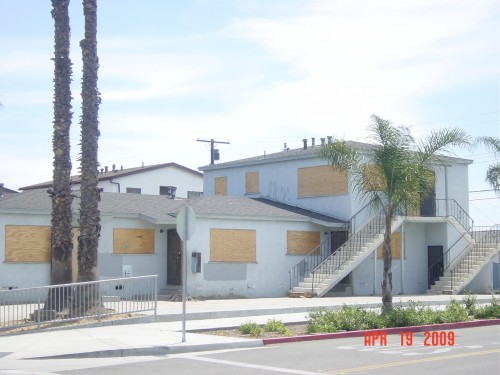This YouTube clip of a recent Fullerton Redevelopment Agency strategy/workshop session is a must see for anyone who wants to see how their decisions are made. The audio has been artfully overdubbed to protect councilmembers from appearing ridiculous and thus preserving the dignity of their office.
Listen to Councilman Shawn Nelson as he effectively guts the findings of blight necessary to establish the proposed redevelopment expansion. He applies intelligence and common sense to this issue that would, if imposed, negatively effect the future of Fullerton. Undeterred by staff and colleague pressure, he stands on principle instead of prevarication and political expediency.
Folks, this is what a real leader looks and sounds like.
One of our sharp-eyed Friends took a photo of this banner last Tuesday morning. By Tuesday night, it was gone.
During its brief life, it asked the telling questions:
- Why is the City Council spending millions of tax dollars to move the McDonald’s?
- How did the Fox project morph into subsidizing teen obesity?
The sign hits McDonald’s hard, though—to be fair—McDonald’s doesn’t want to move at all. Just like the residents who lived in the demolished homes didn’t want to move. Redevelopment hard at work!
- Who tore the sign down? City crews or the McDonald’s owner are the likely suspects.
- Who’s afraid of a little free speech?
After all, that fence is paid for by the taxpayers, just as everything else in this $6 million supersized boondoggle!
And it was covering the eyesore of the vacant lots where vintage homes once stood.
Take pity on your campus, you FHS alums Quirk and Keller! Listen to the District Board members. Superintendent Escalante told City Manager Armstrong back in 2001 that the school does not want a McDonald’s across the street or its drive thru lane accessing already congested Pomona Ave. That information has been covered up for years!
Last night we sat through the horrendous hearing on Redevelopment expansion. It was really a pretty painful thing to have to endure.

City staff and their consultant put on a performance that can only be termed embarrassing. To describe it any farther would do an injury to my synapses, and so I’ll pass. Their presentation was eviscerated by Councilman Shawn Nelson and several speakers from the public – notably former Councilman Conrad Dewitte, former Congressman Bill Dannemeyer, GOP Central Committe member Bruce Whitaker; and perhaps the best of all, Jane Reifer . We note that our lawyer Bob Ferguson showed up too. We can smell a lawsuit coming.
The case boils down to this: you can’t create a Redevelopment project just because you need the money. It’s been done for years, but judges are finally starting to uphold the law. About time.
One of the words that the cheerleaders of the expansion kept using was “tool” and this sure was appropriate since city staff and the Jones/Bankhead team dredged up a number of tools to come to the meeting and add moral support.

There was Theresa Harvey of the Chamber of Commerce who mumbled and stumbled her way through a statement clearly not written by her; a character by the name of Rick (or Dick – can’t remember) Price representing an outfit that goes by the hilarious name “Fullerton Positive” and wears smiley face buttons on their lapels; John Phelps – one of the biggest welfare recipients in Fullerton’s Redevelopment history ; and former councilman Peter Godfrey – who could only be seen from behind. It was nice to see Peter again, if only his backside, to remind us of his vacuous tenure on the council and recall that he was one Linda Lequire whip crack away from voting to keep the obnoxious Utility Tax.

As expected Bankhead and Jones were shilling hard throughout the hearing, Jones giving one of his brilliantly cuckoo rants complete with crazy gesticulations.

Since Pam Keller recused herself, Sharon Quirk became the necessary third vote and she kept noncommittal, sensing no doubt the political pitfalls of either position. She asked a lot of questions that seemed rehearsed with staff, and acted like she wanted more information from the lame consultant. We have to question her sincerity since she’s already had plenty of time to lay out the ground rules before last night – the proverbial 11th hour. And so we got the strong sense of a kabuki performance. The simple fact is that Quirk could have killed the deal last night. The fact that she permitted the monster to live indicates she will be going for this when it comes back on June 18th.


It seems a little strange that an organization that purports to support the interests of business would allow itself to become an impotent pawn in a game run by and for city bureaucrats. And yet that is exactly what has happened.
This afternoon the City Council received an e-mail from Theresa Harvey, Executive Director of the Chamber in support of the proposed Redevelopment expansion on tomorrow night’s City Council agenda. The letter attached to the e-mail would be comical if there weren’t so many dues paying members of the Chamber who will get screwed by Redevelopment.

Harvey starts out by trotting out all the old cliches about infrastructure, housing and business climate. What she utterly fails to mention is how Redevelopment diverts a finite amount of disposable income of consumers from existing businesses to new ones; how it invites bureaucratic interference in business decisions, thus impinging on entrepreneurialism; how it requires business and property owners to endure the idiotic design review process; how it selects favored businesses and “developers” as winners, to the detriment of others. In short: Redevelopment does not work. it is a government ponzi scheme that leverages bonded indebtedness off of property tax revenue; it discriminates against the majority of businesses in favor of a few; and any policy or program that discriminates against the majority of business is, by definition, ANTI-BUSINESS!
Ms. Harvey decorates her tribute to Redevelopment by citing the “charm” of downtown Fullerton. Anyone who has been reading these pages lately knows that whatever charm Fullerton has, it has in spite of Redevelopment, not because of it. Does she support giving away public sidewalks? Does she approve of squandering millions of dollars to move a fast food outlet 200 feet? Does she like giving away free public land to developers? She must. She must like it a lot.

You would think that the businesspeople on the Board of the Chamber of Commerce would have enough sense to grasp these simple notions. But when you reflect on the fact that our old friend Dick Jones, a government educated doctor, used to be the president of the Chamber, the institutional dysfunction of this group can be discerned in much clearer focus. The Fullerton Chamber of Commerce has become nothing but a sissified adjunct of City Hall, confusing their own alleged mission with that of the City apparatchicks.
To the members of the Fullerton Chamber of Commerce: stop paying your dues until your Executive Director and Board start defending business instead of government expansion and bureaucracy!
On May 5th, the Fullerton City Council will once again take up the matter of a vast new Redevelopment land grab in Fullerton. The bureaucrats in City Hall want to appropriate all the property tax that they can by throwing the Redevelopment net over a huge swath of the City. In order to do so they must find “blight” and they must be able to prove it. So far they haven’t. They never will.

What does “redevelopment” mean in practical terms? It means the diversion of property taxes from other government agencies; it means the power of eminent domain over law-abiding property owners; it means more massive developments by favored developers; it means more design mediocrity – or worse.

Devoted Friends of Fullerton, over the past few weeks we have favored you with a litany of loose accountability and lax responsibilty exhibited by Fullerton’s Redevelopment Agency over the years. These sad stories have detailed incompetence, government overreach, bureaucratic usurpation of sovreign authority, the serial uglification of downtown Fullerton; and worse still, our tales have shown the happy compliance and enthusiatic support of the City Councilmembers for all this misfeasance.

Although some of the Redevelopment case studies of mismanagement and boondogglery we have related occurred in the 1990s, nothing has changed. The fact that Don Bankhead and Dick Jones can still cheerlead for this failed – and failing – government entity only goes to show how irresponsible it would be to permit the metastasis of Redevelopment in Fullerton. Harnessed side by side, these two have trudged through the last twelve years approving most of the Redevelopment disasters we have recounted to you Friends.

So now we are at the proverbial eleventh hour; what will happen on Tuesday? Jones and Bankhead(Joneshead?) are on safely board. Nelson is on record as opposing the expansion; Keller seems to be opting out because of a conflict of interest. This leaves Sharon Quirk as the necessary third vote. Although every instinct in her body must be telling her to go with the staff and the good old boys, to just follow on the slip-stream of inertia, we think she may be entertaining some nagging doubts. Even if these doubts are of a political character, we will embrace them as if they were the heartfelt and genuine response to our brilliant posts on the history of Redevelopment disasters in Fullerton.

On Tuesday we will be watching Quirk. She will have the rare opportunity to do the right thing – to refuse the expansion and to say why: Redevelopment does not work. It is a scam. It invests authority in people who are not qualified to exercise such authority and it engenders both incompetent government action and lack of accountability for those who act ineptly or even illegally.
Quirk’s choice is really pretty easy.

Fullerton’s Redevelopment Chairman Don Bankhead, and members Pam Keller and Sharon Quirk led the charge to spend $6 million in tax payer’s money to relocate McDonalds 2oo feet closer to Fullerton High School. As part of the total figure, the Agency previously spent $3 million to buy and demolish four historic California bungalows on the site.
Redevelopment Agency Director Rob Zur Schmiede said “funds for the project had been set aside years ago”. Governments flawed incremental approval process at work again.
The move will pave the way for The Fox Block project– a proposed parking structure type development fronting on Chapman Avenue between Harbor Boulevard and the new McDonald’s which will resemble a McMiniature McSpanish McCastle.
Not everyone favored the deal, longtime Fox critic, Councilman Jones opposed the deal, indicating that he was disappointed a big corporation like McDonald’s was not putting a nickle into the multimillion dollar burger deal.

“This is a huge cost of the citizens’ money,” Jones said.
Councilman Nelson asked if it were possible to postpone the final decision until the Fox Block developer, Arteco Partners, could come up with a plan and a feasibility study.
With nothing at stake and everything to gain, the out of town Developer’s spokesman Jerry Tessier said the new proposed parking structure and project would not work if McDonald’s stayed in its current location. Yet, he could not provide any guarantees for much.
Councilwoman Quirk agreed it was time to move forward. “We have the funds, and we need to get sales tax in.”
 As a school teacher, Quirk must know what causes obesity in children; eating too much of the wrong kinds of food and not getting enough exercise. Now the kids wont have to walk as far to get their subsidized happy meal deals.
As a school teacher, Quirk must know what causes obesity in children; eating too much of the wrong kinds of food and not getting enough exercise. Now the kids wont have to walk as far to get their subsidized happy meal deals.
McDonald’s franchisee Mr. Frisbie reminded the Redevelopment Agency members that the City staff approached him to relocate his business, which was started by his father, James, in 1969 as a family business. A recent study shows the presence of an fastfood outlet within easy walking distance of a high school — about 530 feet or less — resulted in a 5.2% increase in the incidence of student obesity compared with the average for California youths, a correlation deemed “sizable” according to the findings. Great job Quirk, Bankhead and Keller!

“Our business is better suited where we are now,” Frisbie said. Dear Friends but another example that government is part of the problem and not the solution.


Some not so smart landscape planner hired by the Fullerton Redevelopment Agency thought he knew what he was doing when he choose to plant a tree right in front of the Historic Rialto Theater in downtown Fullerton. The Rialto Theater Building is one of the two remaining “Zig Zag Moderne” buildings in Fullerton. What do you think about the landscaping efforts of the Redevelopment Agency in downtown Fullerton?


Loyal Friends, when we left off our last post the City’s chosen SRO “developer,” Caleb Nelson” was gone: whether he left voluntarily or was shoved aside is a moot point. He left behind an unstarted project, a history of City bungling, and an embarrassing hole in the cityscape. Sometime in 1996 Redevelopment Director Gary Chalupsky discovered a replacement. Apparently on his own authority he chose Agit Mithawalla to take over the project. No public hearing, no RFP, no prequalifications, no City Council approval. Behind closed doors a new deal was hatching.

And the City Council had changed. And changed again in the fall of 1996. Jan Flory was now on the Council since 1994, trying to rewrite Recall history and a sure bet to cover up any staff misfeasance. But the newly minted councilman Dick Jones was on the dais. He had run as the voice of conservatism in Fullerton and it was known that his pals in the Chamber were dead set against an SRO across the street. Public housing – the horror!

When the final agreements with Mithawalla finally reached the Council for approval in March 1997 a showdown was prepared by irate citizens who opposed the SRO project for one reason or another. Some cited inflated construction costs; some objected to deal for financial reasons; other attacked Mithawalla’s record of shoddy building in LA. When the vote came down the agreement was voted down 3-2. Bankhead and Flory, predictably, backed up the staff mess completely; Chris Norby rallied Jones and Julie Sa to oppose. Dick Jones gave the very first of his corn pone diatribes, in which he hurled invective against the project, its likely denizens, and the methadone clinic next door.

He was Big. He was Brave. He would soon come to regret giving voice to his peculiar worldview…
Read the rest of “Fullerton’s City Lights”: Part 1 – Part 2 – Part 3 – Part 4 – Epilogue
Not Friends for Fullerton’s Future. We subscribe to the opinion that good architecture – innovative, attractive, engaging architecture, need cost no more than bad architecture – non-functional, boring, banal, tacky architecture. So there’s really no excuse for housing developed by non-profits to be substandard, especially when it relies on huge governement subsidies.
Here’s an example of a subsidized housing project on Chapman Avenue. A hodgepodge of “styles”It was built during the mid-90s and can only be described as, well, really bad. The building closest to the street is a stucco box with flush, cheapo windows, and fake shutters – which have been removed, or mercifully fell off. Well maybe we’re just imagining the shutters. The parking structure actually has little roofed stucco boxes stuck on to the front of it, no doubt to make it look “residential” from Chapman Avenue. We wonder what kind of an idiot would mistake a parking structure for a house; or who wouldn’t be offended by someone’s effort to fool him.

A more recent aesthetic travesty was perpetrated by Habitat for Humanity on Valencia Avenue in the barrio. The theme here seems to be fake Craftsman; the awkward angles and ridiculous fenestration make it look as if an untalented child drew the elevations. Oh boy! fake rock plinths for the porch posts.

Hard to believe, but the apartments the City is buying and demolishing in order to build this other stuff looks better – even boarded up with plywood!

Now, our purpose here is not to belittle people trying to do good, or even to make fun of untalented children. But rather to point out that neither of the these two examples needed to end up like they did – if in fact an intelligent design review process had decided that low income people shouldn’t have to live in cheap-looking, ugly housing.
Of course we have an ulterior motive for this post. First, the Redevelopment Agency is going to be spending ever-increasing amounts on subsidized housing in the coming years, with or without expansion. Regardless of one’s opinion about this sort of government activity we want to make sure that these projects achieve the highest design standards – not the lowest – as has been the case (see also the recent post on the Allen Hotel). Second, and more specifically, we are extremely concerned about the upcoming Richman project. The selected developer, the Olson Co., is not known for their aesthetic creativity, and will, if allowed, cough up another McSpanish McMess. Their architect is the same individual responsible for the Habitat for Humanity project.
It’s time for Fullerton’s Friends to insist on better, sustainable architecture when it’s subsidized by the taxpayers.
We’re all paying for it. Now and in the future.
